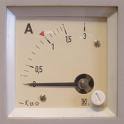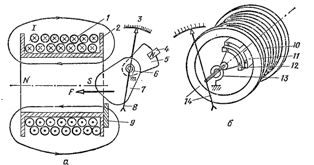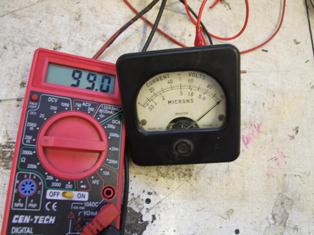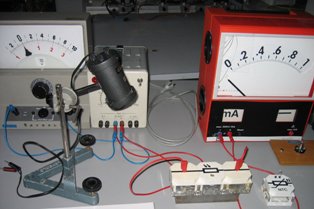What are the advantages and disadvantages of electromagnetic meters?
Electromagnetic measuring devices — devices based on the property of the magnetic field to attract, for example, ferromagnetic bodies. mild steel. When a current flows through the coil, a magnetic field arises in it, which tends to draw inside the coil a steel armature connected to the arrow of the device.
The arrow is held in the initial position by a coil spring. The deflection of the arrow can be used to estimate the strength of the current passing through the coil. Since the current winding draws the armature whether it is supplied with direct current or alternating current, then steel electromagnet meters are equally suitable for measuring both direct current and alternating current.
Thus, an electromagnetic device has an electromagnetic measuring mechanism with a stationary coil, through the coil of which an electric current flows, and one or more ferromagnetic cores mounted on the axis.
Electromagnetic measuring devices are used in ammeters, voltmeters, frequency meters and phase meters.
Electromagnetic devices are produced with a flat or round coil. A flat stationary coil (Fig. 1, a) is usually wound from a thick wire 1 on a non-ferromagnetic frame 2 so that an air gap is formed inside it. A ferromagnetic plate 7 is placed next to the gap, the axis of the plate is located asymmetrically, the arrow 8 of the device is attached to the axis moving along the scale 3 of the device. An opposing spring 6 and an aluminum sector 5 are mounted on the axis, which can rotate in the field of a permanent magnet 4.
 An electromagnetic device with a circular coil is structured as follows. A round coil 10 (Fig. 1, b) with an air central gap is wound from a thick wire. A ferromagnetic plate 11 is fixed inside the gap, and a second but already movable ferromagnetic plate 12 is fixed on the axis. A counterspring 13 and an arrow 14 of the device are fixed on the axis of the plate 12. To create a counter moment, the aluminum sector is fixed on the axis and installed permanent magnet — not shown in the figure.
An electromagnetic device with a circular coil is structured as follows. A round coil 10 (Fig. 1, b) with an air central gap is wound from a thick wire. A ferromagnetic plate 11 is fixed inside the gap, and a second but already movable ferromagnetic plate 12 is fixed on the axis. A counterspring 13 and an arrow 14 of the device are fixed on the axis of the plate 12. To create a counter moment, the aluminum sector is fixed on the axis and installed permanent magnet — not shown in the figure.
Rice. 1. Electromagnetic measuring mechanism: a — with a flat coil, b — with a round coil
Advantages of electromagnetic measuring instruments
The deflection angle of the arrow of an electromagnetic measuring device depends on the square of the current. This implies that electromagnetic system devices can operate in DC and AC circuits.
When alternating current flows through the coil, the movable core is magnetized simultaneously with the change in the direction of the magnetic field, and the direction of the torque does not change, that is, the change in the sign of the current does not affect the sign of the deflection angle. The reading of the device in the AC circuit is proportional to the rms values of the measured values.
Electromagnetic meters are simple in design, inexpensive, especially the panel board. They can directly measure large currents because their coils are stationary and can easily be made from wires with a large cross-sectional area.
The industry produces ammeters of the electromagnetic system for direct connection to currents up to 150 A.
Electromagnetic measuring devices withstand not only short-term, but also long-term overloads, if any, occurring during the measurement process.
Disadvantages of electromagnetic measuring instruments
The disadvantages of electromagnetic measuring devices include: unevenness of the scale and relatively low sensitivity when measuring low currents, that is, relatively low measurement accuracy at the beginning of the scale, dependence of the instrument readings on the influence of external magnetic fields, low-frequency measurement range, high sensitivity of instruments to fluctuations in current frequencies and their high consumption (up to 2 W for ammeters for currents up to 10 A and 3 — 20 W for voltmeters, depending on the voltage).
For many devices, the scale is close to the same.
Electromagnetic measuring instruments are susceptible to the influence of external magnetic fields because they have a very weak intrinsic magnetic field. The fact is that the coils are made without ferromagnetic cores, so the magnetic field created in them is enclosed in air, and it is known that air is a medium with a very high magnetic resistance. To eliminate the influence of magnetic fields, various magnetic shields are widely used or the devices are manufactured in an astatic version.
In astatic measuring devices, instead of one coil with a core, two fixed coils and two cores mounted on one axis with an arrow are used, respectively. The windings of the coils are connected in series with each other and so that when the measured current passes through them, magnetic fluxes directed towards each other are created in them.
If the measuring device is in an external magnetic field, it increases the magnetic field in one coil and decreases in the other. Therefore, an increase in torque in one coil is offset by the same decrease in torque in the other. This compensates for the influence of an external uniform magnetic field. If the external magnetic field is not uniform, only partial compensation occurs.



